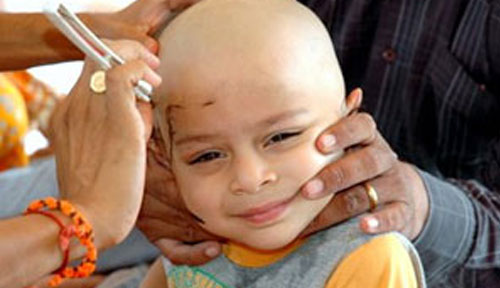Chudakarana Sanskaram : A Sacred & Holy Ritual Of Hair Removal
Chudakarana Sanskaram : The Sacred Ritual of Hair Removal is performed when the baby reaches three years of age. It is a significant ceremony that involves the removal of hair from the child’s head, symbolizing the shedding of their birth hair. This ritual is also known as “chaulamu.”
The purpose of Chudakarana Sanskaram is to purify the child and prepare them for the subsequent rites and rituals. By removing the hair, the child is freed from any negative influences and bestowed with auspiciousness. Vriddhi Shraddha and Homa ceremonies are conducted, where prayers are offered to the Sun, expressing the wish for the child to lead a long and healthy life. Mantras with these intentions are recited during the ritual.
During Chudakarana, only the Sikha hair (tuft of hair) is kept intact, while the remaining hair is removed. Hair is considered a source of strength, and by removing it entirely, the individual is believed to become weaker. The preservation of the Sikha hair is symbolic of Hindu identity, representing strength, virility, bravery, and spiritual elevation. It holds a deep connection to the heritage and values of Hindu culture.
The ancient texts of Sushruta and Charaka also mention the benefits of shaving, such as longevity and beauty. There is no mention in the Grihya Sutras or the Smritis about offering hair to deities. While in the past, there were occasional instances of offering hair (talanilas) in temples, it was limited to specific occasions.
Chudakarana Sanskaram & Performed
Chudakarana Sanskaram is traditionally performed either at the end of the first year or during the third year, as per the Grihya Sutras. However, later interpretations extended the age range up to seven years.
What is Chudakarana?
Chudakarana can be understood as the straightening of the Sikha hair. It is considered a fundamental Sanskara and is typically performed before other Sanskaras (sacraments). The origins of this rite can be traced back to concerns about the child’s health. Recognizing the potential risks associated with hair harboring harmful germs, Chudakarana Sanskaram was introduced.
In earlier times, the act of using a knife near a child’s head may have caused considerable anxiety for parents. Gradually, Chudakarana Sanskaram evolved into a ceremony where parents express their wishes for the well-being and protection of their child. It has transformed into a symbolic removal of the birth hair.
The Procedure for Chudakarana:
According to the Apastamba Samskara Deepika, the following procedure is recommended for Chudakarana. After purifying the designated area, a white thread is tied around five knots, adorned with mango leaves. Soil, along with specific mantras, is poured into these knots, and Navadhyam (offering) is placed in a bronze pot. The area is anointed with cow dung, and the deities are invoked through Shodasopacharam (16-step ritual).
A fire is lit, and the child is made to sit facing east, west of the fire. Three white-spotted cows are placed in front, three bundles of Birjisu bundles end, Raspberry bundles, while these bundles are made together and are moved from the east in circular motions, and hair is made wet.
The hair is gently stroked in a circular motion, accompanied by the chant, “Stop it…”
Using four mantras that signify “For life and radiance, may the water touch this child’s head and allow them to witness the sun for a long time,” the hair is cut in all directions. The cut hair is kept away from manure, and by
touching water and chanting the mantra “uptvaya keshan,” the tree is symbolically planted. The priest then performs a godanam (offering of a cow).
According to the Varaha Grihya Sutra, the mother is advised to avoid consuming sour food, salt, and meals with anger for one year following the Chudakarana rite.
Also Read : Onilu Panchalu : An Auspicious & Sacred Ritual

